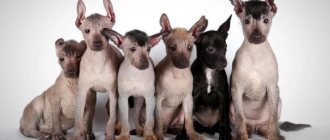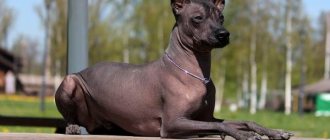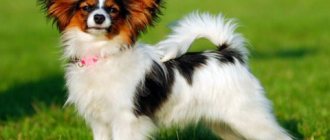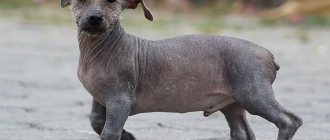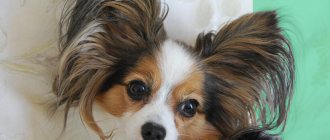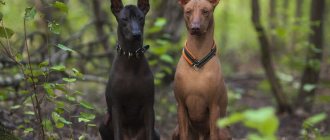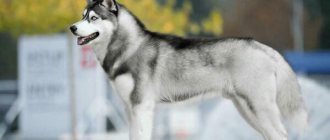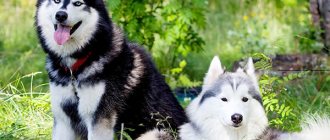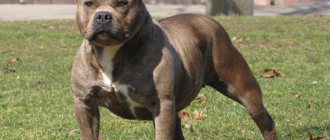Anyone who dreams of becoming the owner of a unique and ancient breed is recommended to pay attention to the Xoloitzcuintle. Hairless dogs are revered for their calmness and loyal nature. In addition, due to the lack of hair, representatives of the breed are very popular among allergy sufferers.
Mexican hairless dog Xoloitzcuintle: character and features
Xoloitzcuintle
In our country, the Xoloitzcuintle is practically not found; its character and exotic appearance were valued by the Aztecs. Here's what you can say about the character of the breed:
- Friendly, treats strangers with contempt, but is always kind and affectionate towards their owners.
- Loves freedom.
- He has a calm character, thanks to this he makes himself the best friend for a person.
- Cheerful, very smart.
- Xolo almost always attracts attention at exhibitions.
- She loves to be praised and follows commands with pleasure.
- Will become the protector of the whole family.
- Needs daily communication with the owner, good company for your other pets, gets along quickly.
- She is very affectionate to all family members, most of all to children.
- When training a pet, the whole family must participate, then the puppy will grow up calm and sociable.
- If only one person cares for the dog, she will become more attached to him than anyone else.
- You should not get this dog if you do not have time, as this dog will demand your attention and cannot be alone.
Features of this breed:
- It was first discovered in Mexico.
- Recognized as the most unusual and ancient breed.
- This breed was bred by the Aztecs and Indians.
- When the Indian had joint pain, he took this dog with him to bed, used it as a heating pad, and it often helped.
If you really want to get a dog of this breed, then you should take two Xolos at once. They will entertain each other in your absence.
New in blogs
Mexico is recognized as the homeland of representatives of this breed, where such dogs are today a pride and national treasure.
The name of the breed “Sholo(xolo)itzcuintli” comes from the name of the god “Xolotl” and the word “itzcuintli”, which means “divine dog” . The origin of the breed goes deep into the history of Mexico, where mummies of dogs were found at ancient burial sites, as well as clay figurines - images of the Sholoitzcuintle. The natives highly valued the taste of the meat of such dogs, and the representatives of the breed themselves were considered to be earthly messengers of the god Xolotl.
The main task of the Sholoitzcuintle was to accompany the souls of the dead to the gates of the afterlife. The famous Franciscan missionary, naturalist and historian Bernardino de Sahagún gave the most detailed description of representatives of the Sholoitzcuintle breed.
This is interesting! Currently, there are several thousand hairless Sholo dogs in Mexico, and the very first representatives of the breed were brought to the countries of the USSR in 1986 from Cuba.
The Spanish conquest of Mexico was characterized by the active extermination of the Sholoitzcuintli, which were usually classified as objects of pagan worship. Very quickly, the Sholo almost completely disappeared, but already in 1954, Norman Pel Wright made an attempt to save the breed. For this purpose, Wright went to the central part of Mexico, where he visited the most remote and forgotten Indian villages by civilization. Norman managed to bargain a dozen purebred dogs from the Indians.
It was possible to restore purebred representatives of the breed quite quickly, so already in May 1956, the hairless Mexican dog was officially recognized at a show in Mexico, and four years later the Mexican Canine Federation registered four dozen purebred Sholos. Five years later, the Sholoitzcuintle population in Mexico already numbered seven dozen purebred individuals.
Description of the Xoloitzcuintle
An important characteristic, but at the same time a certain oddity of the Sholo breed, is the almost complete or complete absence of hair, as well as very delicate and smooth skin. The Sholoitzcuintle's body is distinguished by harmonious proportions, a well-developed chest and broad chest, as well as long legs and tail. The breed comes in two varieties: hairless dogs and coated dogs.
This is interesting! Sholo's skin seems warmer than that of representatives of woolen breeds, which is explained by direct heat transfer, and sweat is secreted by paw pads and interdigital membranes.
Breed standards
According to the FCI classification, Sholo belongs to group 5, including Spitz and primitive dogs, as well as subgroup 6, including primitive dogs without working tests. The three sizes of dogs represented by the breed should be graceful and strong, muscular, with moderate bone structure and a rectangular silhouette.
Approved breed standards:
- the skull is strong and broad, wedge-shaped in shape, elegant, but noticeably tapering towards the muzzle when viewed from above;
- the occipital protuberance is not very pronounced;
- the lines of the muzzle and skull in profile are almost parallel;
- the stop is well defined, but light;
- the color of the nose corresponds to the color of the dog;
- the muzzle in profile is straight, with square and very strong upper and lower jaws;
- the tongue is most often pink, but black markings, stripes or spots may be present;
- lips are tight and dry;
- incisors meeting perfectly in a scissor bite, the upper incisors completely overlapping the lower ones;
- for the bare variety, a full set of incisors is preferred;
- cheekbones are poorly developed;
- eyes of medium size, almond-shaped, with a very intelligent and alert expression;
- eye color depends on skin color and can be black, brown, hazel, amber or yellow;
- the eyelids are well pigmented, black, brown or gray in dark-colored dogs, and pink or light-colored in light-colored dogs;
- the ears are large and long, expressive, pleasantly textured, very elegant and bat-like, alert, symmetrical;
- the neck is set high, smooth and dry, slightly arched, proportionally long, flexible and thin, very elegant and muscular;
- the skin in the neck area is elastic and dense, well-fitting, without dewlap;
- the body is strongly built, with a completely straight and even top line, short and strong, strong back, muscular lower back;
- the croup profile is slightly convex, with a horizontal slope of about 40 degrees;
- the chest is of good width, not protruding, deep and long, reaching down to the elbows, with slightly convex and not pronounced ribs;
- the abdomen is muscular and moderately tucked, with a graceful underline;
- the tail is tapered, thin and long, the presence of individual tufts of hair is acceptable in hairless dogs and full coverage with hair in woolly dogs;
- shoulders are muscular and straight;
- elbows are stable and strong, fitting tightly to the chest, without turning outward;
- pasterns are stable and almost perpendicular to the paw;
- the front paws are medium in length, with tightly knit and curved toes, with strong pads that are very resistant to any surface, as well as well-developed interdigital membranes;
- The hind legs are strong, with well-developed and strong muscles, with very muscular thighs and moderately arched stifles.
The dog should move freely, with an elegant, long and elastic stride, and the trot should be fast and smooth, with the tail and head carried high. The hairless variety is characterized by a complete absence of hair, sensitive to touch and smooth to the touch skin. The skin of woolly individuals is soft, completely covered with hair.
Varieties of Xolo or Sholo are represented by the following colors:
- black;
- graphite;
- light gray;
- dark gray;
- red;
- liver;
- bronze;
- fawn.
This is interesting! Within the breed there are mini, medium and large (standard) Sholo or Xolo, and in terms of gender, the main differences between individuals are in body structure: males are slightly shorter than females.
Regardless of the main color, spots of any color are allowed, including white markings. The sizes of males and females of the “standard” class are 46-60 cm. The height at the withers of medium-sized animals varies between 36-45 cm. Miniature representatives of the breed are characterized by sizes of no more than 25-35 cm.
Dog character, behavior
Sholoitzcuintles are quiet and calm dogs without signs of any unmotivated aggression. Such a very cheerful, vigilant and smart pet may well be suspicious of strangers, therefore it deservedly belongs to the category of good watchmen and excellent companions.
Xolo perfectly senses the mood of his owner, and can also quite easily adapt to the general atmosphere of the house. As a rule, a dog of this breed chooses only one owner, but is quite tolerant of all family members, including small children and small pets.
Lifespan
With strict adherence to the rules of keeping, carrying out all preventive measures, as well as choosing the optimal healthy diet, the average life expectancy of a xoloitzcuintle varies between 15-20 years, which is a very good indicator for dogs.
Contents of the Xoloitzcuintle
The Sholo, or Xoloitzcuintle, belongs to the category of absolutely unpretentious breeds, and therefore does not require any professional or special care at all. As a pet gets older, it is quite natural for the diet, level of exercise, and training of such a pet to change. It is also necessary to strictly monitor the cleanliness and health of your pet. In general, according to Xolo owners, there is no more hassle with such a dog than with any other breeds.
Care and hygiene
Hairless representatives of the Xoloitzcuintle do not have fur that requires special care and combing, but the skin of such a four-legged pet requires attention and care. Xoloitzcuintles are very active and playful, which can cause scratches, bruises and bruises on the skin. In addition, the animal can get dirty, which involves bathing, which is often accompanied by dry skin from shampoo, soap or drying.
Too dry skin of Sholo can cause pain in your pet, so after not too frequent water procedures, it is imperative to wipe the dog’s skin with special oil.
Also for this purpose, it is quite possible to use a moisturizer with vitamin E or almond oil, which is evenly distributed throughout the dog’s body. In the summer, before a walk, the skin of your four-legged pet should be protected from direct rays of the sun using a special cream.
This is interesting! Hairless representatives of the breed need to purchase a special overalls, which will be used on very frosty winter days during walks.
The animal's ears are very delicate and require special care, which should be started from the age of three months, which guarantees their correct position. If necessary, a pharmaceutical adhesive plaster can be used to hold the ears in a raised position. Ears and eyes are cleaned only when they become dirty, with special solutions or boiled warm water. Nails need to be trimmed with special dog nail clippers about once a month. The teeth are brushed daily, and if necessary, the dog is given cleansing food or treats.
Diet, diet
Xoloitzcuintles, along with any other dogs, need sufficient amounts of protein, vitamins and microelements. However, due to the absence of some teeth, as well as the dog's natural tendency to food poisoning, it is very important to pay special attention to the daily nutrition. The diet of such a dog should be completely natural, without preservatives or dyes.
Wet canned food that has a crushed and easily digestible consistency is ideal for feeding Xoloitzcuintle. In order to strengthen the jaws, it is recommended to periodically give your pet solid and finely granulated dog food. If Xolo has a full set of teeth, as well as in the absence of a pair of premolars, it is quite acceptable to use a standard feeding regimen.
Some foreign manufacturers are currently specially producing varieties of dog food that are intended for Xoloitzcuintles. It is strictly forbidden to feed a four-legged pet from the table, which is explained not only by part of raising the dog, but also by concern for Xolo’s health. A professional veterinarian will help you choose the optimal diet for your pet.
Diseases and breed defects
Considering the fact that the selection of the Xoloitzcuintle breed occurred in a completely natural way, without external intervention, hairless dogs have fairly good health. Hereditary diseases include only:
- dermatitis as a result of improper diet or care;
- allergic reactions;
- risk of skin injury;
- Lagg-Calv-Perthes disease, whose clinical manifestations and symptoms resemble hip dysplasia with frequent damage to one joint.
Breed defects can be represented by:
- very wide head;
- raw, sagging or wrinkled skin in adults;
- excessive dewlap;
- eyes that are too light, round or bulging;
- arched (lordosis) or convex (kyphosis) back;
- sloping croup;
- cow delivery;
- a tightly curled tail that hangs over the back;
- short tail;
- loose paws;
- long narrow body with short limbs.
Disqualifying vices include cowardice and aggressiveness, obvious behavioral and physical deviations. Atypical dogs, as well as those suffering from blindness or deafness, are disqualified. Dogs that have an undershot or undershot bite, a pronounced misalignment of the jaws, a bad (weak) bite, a paralyzed tongue, cropped or hanging ears, a short or docked tail are not allowed for exhibitions.
This is interesting! The absence of shortness of breath and rapid breathing is a distinctive feature of purebred representatives of the Xoloitzcuintle breed.
Disqualifying characteristics also include blue or multi-colored eyes, albinism, being tall and short, as well as any coat other than smooth or short. The absence of some incisors, canines, premolars, molars, or deployed teeth in the Xoloitzcuintle is not penalized, since many dogs do not have deep enough dental roots. Genetically, the absence of fur is closely associated with the absence of teeth.
Education and training
All representatives of the Xoloitzcuintle breed are characterized as very smart dogs and always open to communication with their owner, so such four-legged pets are not at all difficult to train and are quite easy to teach a variety of commands. Nevertheless, Xolo owners need to show firmness, perseverance and leadership qualities in the process of raising and training. Otherwise, the risk of your dog developing a variety of behavioral problems increases greatly.
This is interesting! It is very important to prevent Xoloitzcuintle from fighting with other pets or dogs, which is due to the risk of formation of numerous unattractive scars on the delicate skin that are not covered by hair.
Xoloitzcuintles are very intelligent by nature and also have a good memory, so mastering simple commands from the general training course does not cause difficulties. It is necessary to start training and raising such a four-legged pet from puppyhood.
In the very first days after adaptation, Xolo must get used to his place and nickname. Completely ill-mannered representatives of the breed can become a real disaster. Such a dog is characterized by uncontrollable behavior and excessive curiosity, which can harm even the pet itself.
Buy a Xoloitzcuintle
The Mexican Hairless is an extremely rare breed of dog in our country, so those who want to purchase a promising Xoloitzcuintle pet most often turn to foreign kennels for help.
What to pay attention to
After choosing a kennel or breeder, it is important to pay close attention to the conditions in which breeding dogs and their offspring are kept . It is also advisable to get acquainted with the parents of the chosen puppy and observe their behavior in a familiar environment for dogs.
The appearance and behavior of the Xolo puppy itself is of no small importance. The animal must be inquisitive and not cowardly, active, but not at all aggressive, with a good appetite, and also with an exterior that is fully consistent with the breed. Small Xoloitzcuintle puppies have characteristic folds in the neck area, which in purebred individuals disappear with age.
This is interesting! Some problems associated with Xolo's health cannot be identified before the age of two, since their manifestation is most often associated with the pet reaching maturity.
The temperament of a puppy directly depends on many factors, including not only heredity, but also education, training, as well as timely and competent socialization. Puppies with a very good temperament are distinguished by their innate playfulness, do not terrorize their relatives, but also do not hide in a corner from them.
Obvious health defects can be represented by a bloated tummy, scratching on the skin, discharge from the ears or nose, and watery eyes. It is necessary to check the oral cavity of the Xoloitzcuintle puppy, carefully examining the bite, the condition of the teeth and gums, and also make sure that there is no plaque on the tongue. If you have any, even the slightest, doubts about the health of the puppy, you should refuse to purchase it.
Price of a purebred puppy
The average price for Xoloitzcuintle puppies ranges from 15-20 to 50 thousand rubles, but can be noticeably higher. In the process of pricing for representatives of such a breed, the age of the animal, its class, exterior features, pedigree and some other factors must be taken into account.
Owner reviews
Xoloitzcuintle dogs not only have a very unusual and funny appearance, but also have a reputation for repelling evil spirits. Representatives of this breed appeared in our country relatively recently, but have already managed to win the sympathy of dog breeders.
According to Xolo owners, adult dogs of this breed, as a rule, have a very calm character and prefer to stay away from strangers, while maintaining an attentive attitude towards their family members. Daily walks or energetic games can fully satisfy the four-legged pet’s need for physical activity, and the rest of the time such dogs prefer to relax quietly in their place or next to their owner.
Despite the fact that the Xoloitzcuintle breed is classified as problem-free in terms of character and behavior, such four-legged pets require early socialization and competent upbringing. Pets that are not well socialized may be aggressive towards unfamiliar people or animals . Only a strong will, as well as a fair hand, will allow you to raise a well-mannered and obedient dog, devoted and faithful to its owner.
Downy Xoloitzcuintle in wool: photo
It was said above that the Xoloitzcuintle breed has two varieties: hairless and with fur. These two species are similar in body structure and character. They get along well with others, especially with children, separating their toys from others. Here is a photo of dogs of this breed:
Xoloitzcuintle
Xoloitzcuintle Xoloitzcuintle Xoloitzcuintle Xoloitzcuintle
It is worth noting:
- When breeding this breed, the dogs were not always completely hairless.
- Initially, pets with fur were not recognized as purebred animals, were disqualified from exhibitions and were prohibited from breeding.
- They tried to breed them out.
- By crossing hairless dogs with each other, breeders noted that litters produced puppies covered with hair—downy in their coats—since it is impossible to completely get rid of this gene.
Future owners of dogs of this breed should know:
- Constant discussions around unrecognized dogs as individuals with fur led to a group of activists writing a petition to the cynological union.
- A petition signed by breeders in many countries led to the recognition of this breed.
Features of this breed:
- This is because it has no undercoat, so the dog does not shed.
- The exception is the teenage period when the puppy's coat changes to that of an adult.
- The coat is short and lies tightly to the body, completely covering the dog and without any unpleasant odor.
- Another advantage is its smooth coat, no combing procedure and treatment with special creams to avoid sunburn.
Xolo downy tolerates car trips very well and loves to travel and walk with all family members.
Breed standard and species
Three types of Xoloitzcuintle breed :
- Standard.
- Dwarf.
- Toy.
Each of them differs in weight and height at the withers. So the tallest representative of the breed reaches 60 cm in height, the average one – 43 cm, and the shortest – 22-25 cm. Dogs from the standard type are the most massive, weighing up to 18 kg, dwarf dogs – up to 11 kg and toy dogs – up to 5 kg.
Representatives of the breed are also classified based on the presence of fur. Most of them are completely hairless, some have guard hairs on their faces, and only a few are born with fur. They are no different in appearance and habits.
Let's take a closer look at the breed standard. The Xoloitzcuintle in the photo looks like a Sphynx cat. He is just as gentle, sophisticated, and most importantly - completely devoid of fur.
Interesting ! The body of females of this breed is longer than that of males. This feature was given to them by nature to make feeding the puppies easier.
The dog's back is straight and elongated. The neck is muscular and has a curve. When a baby Xoloitzcuintle is born, this part of its body is covered with large folds of skin. Over time, the skin on their neck smooths out. If an adult dog of a given breed has them, he is considered not a purebred.
Despite the lack of hunting skills, it has the strongest knee joints on its hind legs, allowing it to push off the ground well in order to make a dash and run quickly. The legs are placed symmetrically. If an individual is born with a dewclaw, it must be removed.
Otherwise, she will not be able to take part in the dog competition. The tail of the animal is very thin, bare, but slightly thickened at the base. It is in a lowered state. The animal rarely wags at it, even if it is in a good mood.
Important ! If a dog's tail is tucked to its stomach, this is a clear sign of fear. Have pity on the animal so that it feels protected.
The body type of the Xoloitzcuintle closely resembles the classic body of a hunting hound. He has the same sunken belly, thin chest and high paws. But the hunting instinct of such an animal is underdeveloped.
The dog's head is small, but harmonizes well with its long, thin neck. The muscles on the muzzle are well developed. The bridge of the nose is straight. The lips are dry, pressed against the teeth. No drooling from the mouth. Malocclusion is the main reason a dog is disqualified from competition.
Some individuals do not have molars from birth. The standard allows for such deviation. The color of the nose can be black, pink or brown (depending on skin tone). The dog's eyes are small, like beads.
The iris can be colored gray or brown. Dark eye shades are more appreciated. The animal's ears are erect and large. They can change position, such as turning forward, if it is interested in something.
Important ! It is worth noting that the population of such dogs in the world is small. There are only a few high-breed representatives among them.
Even though the Xoloitzcuintle is a hairless breed (most of them), it does have some short fur on some areas of its body, such as its face, paws, or tail. Individuals with a small tuft on the top of their heads look a little funny, but cute. According to the standard, the coat of such a dog should be extremely hard.
“Puff coats” (dogs whose body is completely covered with fur) should not be bred. As for the skin color of these animals, it can be pinkish, brown, brown or sandy. The standard also allows for stains.
Mexican Xoloitzcuintle mini: sizes, photos
According to canine requirements, this unusual breed comes in different sizes: mini, medium and standard. The most popular is the mini standard, since its miniature dimensions - from 25 to 35 cm - allow you to take it with you everywhere. Here is a photo of this dog:
Xoloitzcuintle Xoloitzcuintle Xoloitzcuintle Xoloitzcuintle
- Mexican Xoloitzcuintle bitches differ from cables in their size. They are slightly smaller, which is due to their reproductive functions.
- The Xolo Mini's head is small and wedge-shaped.
- Despite its small size, it has a strong jaw with a tight bite.
- The tongue is usually pinkish, but may also contain black specks, which is typical for this breed.
- The eyes, like those of a large dog, are almond-shaped, the color scheme varies depending on the skin tone.
- The ears are bat-like and stand up when alert.
- The Xolo especially attracts attention with its graceful and graceful neck.
- Proportion and flexibility are emphasized by strong muscles.
When touched, the skin feels warm, smooth and soft, which requires additional care in the summer due to the lack of natural protection. Due to the lack of hair, this breed, even in extreme heat, occasionally breathes through its mouth, and sweat occurs through its paws.
Xoloitzcuintle – interesting facts
The Mexican Xoloitzcuintle dog is known for the following interesting facts:
- The skin of such animals seems warmer than that of other breeds. This is due to direct heat transfer.
- Although the breed is considered hairless, sometimes specimens are born covered with hair.
- Xolos are considered the earthly representatives of the god Xolotl.
- There are about 30 thousand individuals in the world
- Sholo is part of the history of art of the 20th century, because it was often depicted in paintings.
- Purebred representatives are distinguished by the absence of shortness of breath and frequent breathing.
Xoloitzcuintle dog breed: education and training
Xoloitzcuintle
The Xoloitzcuintle is one of the new breeds that is gaining increasing popularity. However, few know how to raise them and whether they can be trained. Here are some tips:
- There are no difficulties in raising this breed of dog.
- Their character is quite calm, but it is necessary to pay attention to her behavior from the first days of her appearance in the family.
- Xolo has a human mind and responds well to various training methods.
- It can easily be taught various commands, such as: sit, lie down, give a paw.
- By using praise and treats during training, you can speed up the process of perceiving the required commands.
- Special attention should be paid to controlling your intonation when executing commands.
- The voice should be calm, demanding and convincing.
- Don't forget that puppies love to play, so it is recommended to practice some commands in a playful way.
From the first days of the puppy's birth, training must be carried out every day to obtain the intended results:
- The first step is to gain your pet's trust.
- Don't lie or tease, as this will discourage compliance.
- This breed of dog allows you to train it at home.
- However, if you do not have the basic knowledge for proper training, you can contact a specialist and invite him to a few classes, or you can do some training together.
A feature of this breed is its hostile attitude towards strangers. But if you approach her upbringing correctly, the Xolo will not show pronounced aggression towards others. Love and harmony will allow you to grow your pet into a devoted family friend.
Xoloitzcuintle training
Along with positive character traits, Mexicans are distinguished by their stubbornness and willfulness. You need to start parenting immediately after the baby arrives in the house. Only positive methods can be used. The hairless Xoloitzcuintle dog should be trained gradually and logically. With gentle and at the same time strict treatment, the baby will immediately understand what is right and what is wrong.
Pranks are stopped with a stern look without shouting or hitting. In order to feel normal on the street, surrounded by people and animals, socialization is important for a puppy. For successful training, the dog needs to be interested. Rewarding with a treat or affection will significantly increase results. Beginners are advised to turn to professional dog handlers for help.
Xoloitzcuintle: care and maintenance
Xoloitzcuintle
Xoloitzcuintle is one of the oldest and rarest dog breeds. But at the same time it is the best option for apartments. Keeping representatives of the Mexican naked does not cause any particular difficulties:
- Xolos are quite active dogs, but they need less regular physical activity than other breeds.
- Some owners teach their pets to relieve themselves in a special tray without taking them outside.
- The “naked people” perceive this absolutely normally.
Due to the lack of hair, the main care for such dogs is related to the skin:
- Although it is elastic, dense and resistant to damage and insect bites, it still needs to be taken care of carefully.
- Using shampoos, Xolos are washed as they become dirty.
- After the bath procedure, be sure to rub oil-based moisturizers into the skin to avoid drying out.
Important to know: In winter, at temperatures below -10 degrees , during snowfall or strong winds, dogs must wear protective overalls lined with plush or fleece. In summer, it is necessary to lubricate animals with sunscreen to avoid exposure to ultraviolet radiation.
According to the standard, the ears of dogs of this breed should be vertically raised, but not cropped. To do this you need to do the following:
- Starting from the age of three months, they are fixed in a raised state using a thin stick or a pen rod and an adhesive plaster.
- The structure is left for 2 days, and then rest for a day.
- The procedure is repeated until the full effect is achieved.
Treatment inside the ear and cleansing of the eyes is done weekly with cotton wool or a cotton cloth soaked in water. The claws of the Xtoloitzcuintle are trimmed as they grow. Due to incomplete dental formula, caring for this part of the body is especially important. For cleaning, use special brushes and anti-plaque sprays, and rawhide sticks.
Mexican Xoloitzcuintle dog: health and disease
Xoloitzcuintle
Let's take a closer look at the health and diseases of the Mexican Xoloitzcuintle dog.
- This dog breed is resistant to infectious diseases and has an enviable immunity.
- But widespread “canine” ailments began to appear more and more often after the intervention of breeders in the development of the breed.
The following diseases occur in this breed:
- The appearance of plaque on the skin with an unhealthy color and odor.
- Weak cartilage (droopy ears effect).
- Burns from direct sunlight.
- Allergic rashes.
- Tooth loss (increases with age).
- Dermatitis, eczema - most often caused by sunburn.
- Joint dysplasia - dislocation of the kneecap.
- Gastrointestinal diseases - gastritis.
- Colds - with hypothermia.
On average, the life expectancy of hairless Mexican dogs is from 15 to 20 years . This breed of dog thrives in any climate zone, but in cold areas it is required to wear insulated overalls to prevent it from catching a cold. The following should also be noted:
- A feature of the Xoloitzcuintle's skin is its rapid regeneration from scratches and cuts.
- Particular attention should be paid to the care of the skin and cartilage of large ears.
- When playing outside, your dog can easily get scratches and cuts, which should be treated with antiseptic agents.
- The puppy's ears should be glued so that they are stable by the time they are one year old.
Although the Mexican Xoloitzcuintle dog has a strong immune system, there is a chance that your pet will contract a dangerous infectious disease. To prevent this from happening, the dog must be vaccinated in a timely manner. Puppies from reputable sellers must be vaccinated according to schedule before being sold. This is indicated in the documents for the dog.
Xoloitzcuintle - pros and cons
The advantages of sholo include the following points:
- exotic appearance;
- graceful and dexterous movements;
- high level of intelligence;
- excellent guard qualities;
- loyalty to the owner.
With all this, the breed is considered “primitive”, which means that it is similar to its wild ancestors in many ways. The Mexican dog has the following disadvantages:
- great need for attention;
- suspiciousness due to poor socialization;
- sensitivity to stress and rough treatment;
- love of digging or trying to climb over fences;
- the need for quality skin care.
Xoloitzcuintle dogs: price of puppies in Russia
Xoloitzcuintle
The Mexican hairless dog Xoloitzcuintle captivates many with its unusualness. How much do puppies of this breed cost in Russia?
- Often the price depends on the “noble” blood and titles of the parents, the requirements of the breeder or online seller.
- Naturally, puppies with a pedigree from specialized foreign nurseries will cost much more than a representative of the breed without documents purchased through an advertisement.
- On average, the price for a xoloitzcuintle is 40-50 thousand rubles . Although there are cheaper options - about 3 thousand . But there is no guarantee that a puppy purchased “on occasion” will have the appropriate appearance.
It is worth remembering: There is a mini-version of this breed (read above in the text). This does not affect the price in any way, but it can be confusing when purchasing.
Starting from 30,000 rubles, you can count on a pet that has all the necessary documents (metrics, veterinary passport), as well as a brand and a microchip. Although, if a representative of this breed is purchased not for exhibitions, but for friendship, it is also quite possible to choose a cheaper option.
Description of the Xoloitzcuintle breed
With a very long history, Xolos (Sholos) still remain very rare dogs. The main points of the breed description are as follows:
- Xolo dog comes in three types: standard, medium and mini:
- Only one person is recognized as the owner;
- dogs sense an uninvited guest long before its active manifestation;
- Families with small children are not recommended to have a breed;
- the pet needs active walks;
- training should be carried out creatively;
- dogs are very smart and this must be taken into account when communicating with them.
Having decided to become the owner of this breed, you need to know how much a Xoloitzcuintle costs. The cost depends on the pedigree of the parents and the appearance of the baby. So a purebred representative with partial compliance with the standard can cost $160. Elite puppies will cost much more and the price can reach $2000. Such babies are used for breeding work or participation in various exhibitions.
History of the Xoloitzcuintle breed
Archaeologists have found evidence of the existence of these dogs during excavations of Mayan, Toltec and Aztec tombs dating back more than 3,500 years ago. At that time, they were used as guards and protectors, giving them superpowers. Representatives of the Mexican Hairless Dog were sacrificed and buried with the owner so that they would help the soul in its journey through the underworld.
Among ancient people, dog meat was considered a delicacy and was consumed only during holidays. Their value in ancient culture is confirmed by their frequent appearances on artifacts. Before European colonization, Xoloitzcuintles were considered sacred. Currently, the Xolo is the national dog of Mexico. There are people who believe that the breed is endowed with healing qualities and can help the sick.
Xoloitzcuintle standard
It is known that Xolos come in three types:
- standard
: height – above 50 cm, weight – more than 10 kg; - medium
: height – up to 45 cm, weight – up to 10 kg; - mini
: height – up to 35 cm, weight – up to 8 kg.
The Xoloitzcuintle dog breed has the following appearance characteristics:
- the head is wolf-shaped and graceful;
- ears set high;
- almond-shaped eyes, color depends on coat color;
- the jaws are equipped with a scissor bite;
- the body is moderately stretched;
- the chest is narrow and dropped to the level of the elbows;
- the tail is thin, the tip is decorated with a tassel;
- dry limbs, hare-type paws;
- There is no hair, there may be a scruff and mane.
Character of the Xoloitzcuintle
Dogs of this breed are distinguished by a high level of intelligence, calmness and silence. Xolos are very vigilant and suspicious of all strangers. Alert to the approach of a stranger is expressed by the dog's fussiness. The breed is easy to train, reserved and balanced. A Xoloitzcuintle dog, if properly socialized, will get along well with other pets, but may show some aggression towards other people's animals.
The dog requires mandatory completion of an obedience course; the owner must be a leader and authority for him. The pet will be delighted with the trip or other accompaniment of the owner, because their affection subtly borders on obsession. If you cannot devote a lot of time to your Xolo, it is recommended to get a second dog of this breed. They will find a common language and will play without annoying family members.
Xoloitzcuintle color
The Mexican Hairless Xoloitzcuintle dog comes in the following shades:
- black
; - red
; - gray
; - shale
; - hepatic
; - bronze
.
Where are the Xoloitzcuintle nurseries located?
Xoloitzcuintle
The Xolo breed requires a careful approach to choosing a puppy. In order to choose the right purebred pet, you need to contact specialists who are professional breeders and have a veterinary or canine education. They will competently talk about this breed, habits, health, character and lifestyle.
Kinich Ahau nursery is one of the best in Russia:
- This organization has all the necessary certificates and is registered with the International Canine Association.
- She has many World and European champions in her collection.
- Pets are winners of major exhibitions and receive excellent reviews from respected experts, demonstrating the beauty and grace of beautiful Xolos.
The RND HAIRLESS nursery is a monobreed and breeds standard size xolos:
- This is a family-type kennel, that is, all dogs live permanently with their owners at home.
- They prepare for each litter very responsibly and thoroughly. All pets must have a full range of vaccinations, branding and specialized documents.
Kennel GRIS MONTENEGRO:
- Engaged in breeding miniature and medium-sized Xolos.
- All dogs have excellent grades and titles, promising for breeding.
- The main goal of the kennel is to produce beautiful, healthy dogs with adequate mental health.
- Dogs and puppies of the kennel successfully perform at exhibitions, including special breed exhibitions, often taking the lead. They are worthy competition among the leading representatives of this ancient breed.
Remember: Choosing a pet is a responsible step, and therefore this procedure should be taken very seriously. A puppy is not a toy; it needs careful care, proper upbringing, health care and responsibility for its life in our world.
Xoloitzcuintle dog: reviews from owners
Xoloitzcuintle
The Xoloitzcuintle breed formed independently without human intervention, which is why these dogs are classified as primitive breeds. Such dogs are distinguished by good health, rarely have genetic diseases and are long-lived.
Here are reviews from the owners of these dogs:
- Artem, 24 years old My Alejandro is wonderful. He doesn't shed at all, is friends with everyone, playful, loyal, obedient. I always take it with me on trips, on vacation, and when I go shopping. When I lie down on the sofa after work, he will quietly lie down next to me. The only negative about it is allergies, which appear on the dog’s skin in the form of rashes. It took me a long time to select food for him.
- Nikita, 20 years old When my sister gave me a puppy, I immediately named him Baloo. He has a wonderful assortment in his wardrobe, and we constantly dress for walks in similar looks. Baloo is very smart, loyal, not picky about food, you can even talk to him, tell him about your experiences, and he looks straight at me with a knowing look and starts licking me.
- Nikolay, 48 years old I’ll tell you from my experience, I love dogs, but I didn’t get them for only one reason, that’s because they shed. But my son was once looking up dog breeds on the Internet, and I saw this miracle. The decision was immediate and I bought a Xolo dog. And now Rose is a favorite pet not only for our entire family, but also for our neighbors. If you are eager to have a pet that will constantly delight you, welcome you home, lift your spirits and create comfort in your home, then buy a Xoloitzcuintle, you will not regret it.
Clothes for Xoloitzcuintle
If dogs have a high tolerance to cold weather and precipitation, it is recommended to buy a warm and comfortable wardrobe for the dog. Clothing should be comfortable, made from natural material and not restrict movement. The most popular options for Xoloitzcuintle are:
- warm suit;
- protective overalls;
- comfortable sweater.
A Xolo dog will look very fashionable in these outfits:
- bright dress;
- original vest;
- comfortable sports suit.
